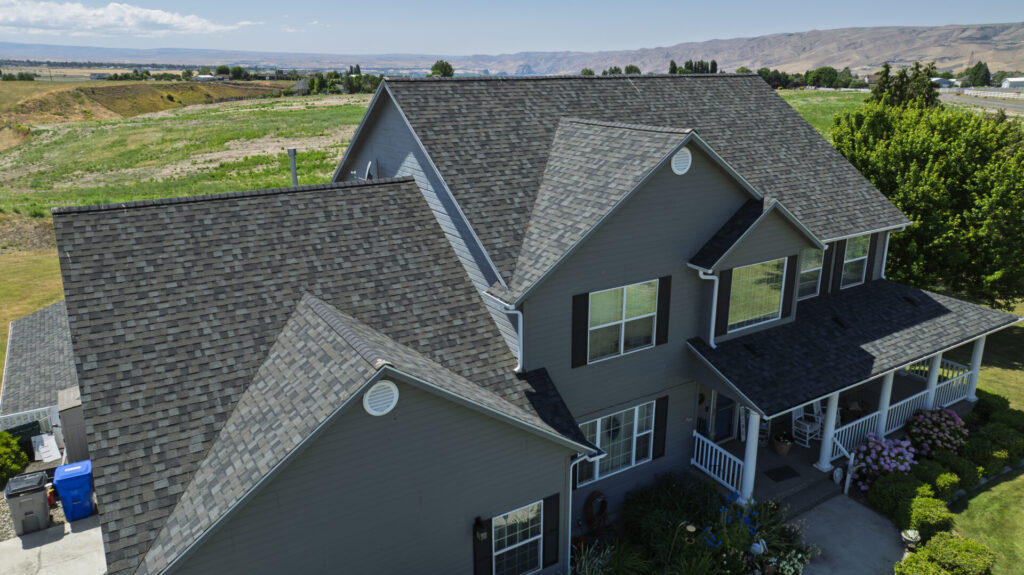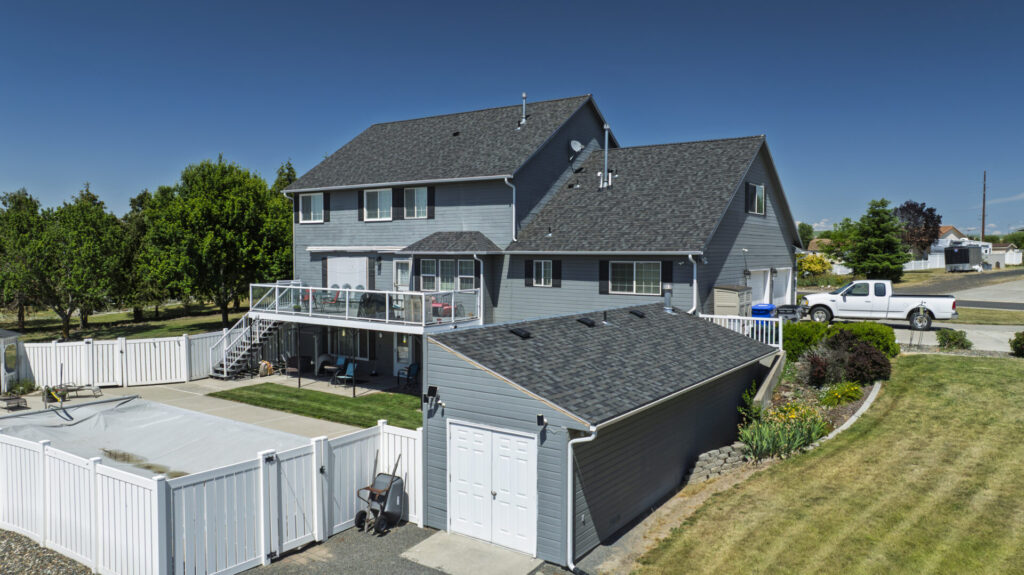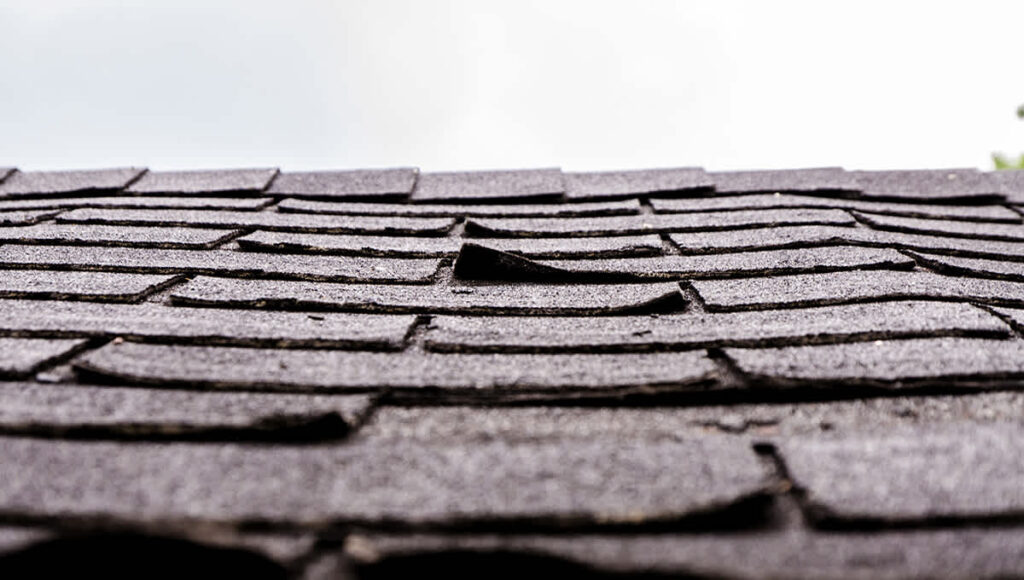Every roofing material we install weathers differently in our Lewiston mix of sun, wind, and snow. Understanding how often to replace roof components helps you plan effectively. We’ll cover the lifespan of each material, the factors that accelerate aging, seven clear signs that indicate you need a new roof, how to assess your roof’s condition, and practical tips to extend its service life.
Typical Lifespans of Common Roofing Materials
Different roofing materials age at different rates. In Lewiston’s mix of sun, wind, and occasional heavy snow; Understanding each material’s expected lifespan and factoring in the roof’s age helps you plan ahead.
 Asphalt Shingles
Asphalt Shingles
Asphalt shingles are the most common choice for homes in our region, offering dependable protection and a wide range of styles. Traditionally, older shingle technology delivered a service life of about 20–25 years before UV exposure, wind, and water runoff caused cracking, granule loss, and reduced water resistance.
The shingles we utilize, however, are built with advanced Owens Corning technology that significantly extends performance. Features like reinforced layers and improved granule adhesion help slow weathering, resist wind uplift, and maintain water resistance for decades. Many Owens Corning shingles also come with lifetime limited warranties of up to 50 years, giving homeowners greater peace of mind and long-term value.
Key takeaway: While older asphalt shingles typically needed replacement after 20–25 years, modern Owens Corning systems provide far longer lifespans and warranty protection—even in regions with harsh winters and hot summers.
Standing-Seam Metal Roofs (40–50 years)
Metal roofs—especially standing-seam panels—offer long-lasting protection. Their interlocking seams and concealed fasteners make them highly resistant to wind uplift and water intrusion.
Metal is also fire-resistant and reflects heat, helping keep your attic cooler in summer. However, expansion and contraction due to temperature swings can stress fasteners and seams over time.
- Key takeaway: Expect 40–50 years of service from a well-installed metal roof.
- Adjustments: Coastal or high-wind areas may require more frequent inspections to ensure seams remain tight.
Local Climate Impact
Lewiston sits where the Snake and Clearwater Rivers meet, bringing both dry, sunny summers and cold, wet winters.
Heavy snow and ice dams can accelerate shingle wear, while gusty spring and fall winds can lift shingles and loosen sealants. UV exposure in summer further hardens roofing materials.
- Snow load: Ice dams trap melting snow, forcing water under shingles.
- Wind zones: Gusts over 60 mph test fasteners and edges.
- UV exposure: Intense sun breaks down granules and asphalt binders.
Accounting for local weather patterns helps you decide whether to adjust replacement schedules by a few years in either direction.
How Often Do Roofs Need to Be Replaced: General Guideline
As a rule of thumb:
- Older Asphalt Shingle Roof: Replace in 20–25 years.
- Owens Corning Asphalt Architectural Shingle Roof: 50 year warranty.
- Metal Roofs: Replace every 40–50 years.
However, this assumes good installation, proper maintenance, and moderate weather. You may need to replace sooner if:
- Your attic ventilation is inadequate, causing heat buildup that can lead to shingle degradation.
- The underlayment fails, allowing hidden moisture damage to occur.
- You live in a high-wind or heavy-snow zone where stress on roofing materials is greater.
A proactive roof inspection schedule, at least once a year, helps you decide whether to extend or accelerate those timelines.
Factors That Influence Replacement Frequency
Even the best-built roof needs care. These factors can shorten or lengthen its average lifespan:
- Extreme Weather: Heavy rain, ice dams, and wind can cause materials to wear unevenly.
- Installation Quality: Proper flashing, underlayment, and fasteners prevent early failure.
- Maintenance History: Regular gutter cleanings and minor repairs prevent small issues from escalating.
- Roof Pitch & Exposure: Steeper or south-facing slopes shed debris and moisture more quickly; shallow or shaded slopes retain moisture for longer.
Regular maintenance and high-quality installation are your best tools to maximize lifespan.

8 Signs a Roof Needs to Be Replaced
Your roof protects your home from rain, wind, and extreme temperatures. Despite its importance, many homeowners aren’t aware of the signs their home’s roofing system is beginning to fail, which can lead to severe water damage.
So, recognizing early warning signs allows you to plan a new roof installation before water leaks or structural damage occurs.
1. Curling, Buckling, or Creased Shingles
When shingles lose their seal or become saturated, their edges begin to lift and bend. You’ll notice the surface no longer lies flat—tabs curl upward or form sharp ridges where the granule layer has folded.
These deformations break the weather barrier, allowing rainwater to infiltrate the underlayment and roof deck below.
- Look for: Wavy lines across shingle fields; corners that stand proud of the roof surface
- Inspect: Creases or sharp folds where shingles have buckled under stress
- Watch: How these areas react during rain—if water pools or drips through, the damage is advanced
- Ask yourself: Do I see any areas where my shingles have curved or buckled under their own weight?
If curling or buckling appears over a broad area, small repairs won’t suffice. This level of deformation indicates the shingles have reached the end of their life expectancy and that a roof leak may occur if they are not replaced to restore full protection.
2. Missing Shingles (or Displaced)
When wind slips under a shingle’s edge, it can pry the tab right off the roof deck. You’ll see bare patches where pieces should be, and you might even find missing shingles in your yard or gutters.
Left unattended, these openings allow rain to soak through the underlayment and rot the wood deck beneath.
- Look for: Bare spots on the roof; shingles in gutters or scattered below.
- Watch out: Dark streaks on the underlayment or softened spots when you walk in the attic.
- Ask yourself: Have I seen loose shingles around my home after the last storm?
 3. Lifted or Curling Shingle Tabs
3. Lifted or Curling Shingle Tabs
Wind uplift can break the adhesive seal that holds shingles in place, causing the edges to bend upward. These curled tabs create a small gap where water can slip under and weaken the underlayment. Over time, that trapped moisture softens the decking and leads to repeated leaks.
- Spot the curl: Run your hand gently over shingles—anything that lifts is suspect.
- Check for ridges: Creased lines mean the shingle has folded back on itself.
- Question: Do any shingle corners pop up when you inspect your roof?
4. Granule Loss in Gutters
Shingle granules protect the asphalt core from UV rays and help channel water off the roof. Heavy winds and rain wash these mineral grains into your gutters, leaving shiny, bare spots behind. Without that shield, shingles age faster, becoming brittle and prone to cracking, which can also promote algae growth .
- Inspect: Dark, sand-like sediment in downspouts after a storm.
- Note: Smooth, glossy patches on shingles where granules are missing.
- Ask yourself: Am I cleaning out more granules than leaves this season?
5. Cracked Shingles (or Torn)
Debris hurled by wind, such as branches, gravel, or tools, can split shingles along the nail line or tab edge. Even hairline cracks allow water to penetrate and damage the underlayment. Over time, those splits widen, leading to soaked decking and interior leaks.
- Look for: Fine lines or breaks running across shingle tabs.
- Check: Small punctures or holes where objects struck.
- Question: Do I see any cracks or tears when I scan from the ground or attic?
6. Debris Impact Dents & Scratches
High-speed debris can dent metal panels or scratch away the granule layer on asphalt shingles. On metal, dents hold water and accelerate corrosion; on asphalt, scratches form little cradles that trap moisture. If left alone, these imperfections grow into full leaks.
- Scan: Small pits on metal panels; gouges on shingle surfaces.
- Observe: Areas under overhanging trees where debris collects.
- Ask yourself: Are there fresh impact marks after the last windstorm?
If you’ve spotted key warning signs and decided it’s time to replace your roof, our professional roofers offer a full replacement service.
7. Damaged Flashing & Roof-Wall Seals
Flashing seals joints around chimneys, vents, and where the roof meets the walls. Strong winds loosen or bend flashing, and sealant can crack under pressure. Gaps here are prime entry points for water, allowing hidden damage to occur behind siding and within walls, hence the importance of a professional inspection.
- Inspect: Gaps or bent metal at flashing junctions.
- Note: Cracked or missing sealant beads along edges.
- Question: Have I noticed rust stains or damp spots near my chimney or vents?
8. Interior Water Stains During Storms
When wind-driven rain finds a path through damaged shingles or flashing, it shows up as brown or yellow rings on your ceiling. Active drips during heavy rain mean water is breaching your roof assembly. If you ignore these stains, you risk warped joists, ruined insulation, and mold growth.
- Look for: New or expanding stains on ceilings or walls.
- Check: Buckets or towels catching drips during a storm.
- Ask yourself: Do I see damp spots inside when it rains hard outside?
How to Assess Your Roof’s Condition
As a homeowner or building owner, you can easily spot signs of damage. Just follow these steps:
- Annual Roof Inspections: A professional walkthrough helps catch hidden issues before they worsen.
- Interior Checks: Inspect your attic for moisture, mold, or daylight shining through the roof boards. Unfortunately, moss and algae can cause significant damage to your roof and home.
- Exterior Surveys: After storms, walk around your home, scanning for granule loss, lifted shingles, or loose flashing.
A combination of professional roof inspections and homeowner checks ensures no problem goes unnoticed.
Tips to Extend Your Roof’s Service Life Expectancy
- Schedule Biannual Cleanings: Keep gutters clear and remove debris to prevent water backup.
- Promptly Repair Minor Damage: Fix small tears or loose shingles immediately to stop leaks.
- Upgrade to Wind- and Hail-Rated Shingles: Selecting higher-rated products during reroofing can significantly extend your roof’s lifespan.
- Ensure Proper Attic Ventilation: Balanced intake and exhaust vents prevent heat buildup and moisture traps.
With simple routine maintenance, you can often extend your roof’s lifespan closer to its maximum potential.
Ready to Schedule Your Free Roof Inspection?
By understanding the lifespan of each material, watching for early visible signs such as curled shingles or leaks, and scheduling regular inspections, you’ll know precisely when it’s time for complete roof replacement. To ensure you receive a roofing contractor’s inspection, contact us today!
AWARD WINNING PRODUCE
Order Online
Lorem ipsum dolor sit amet, consectetur adipiscing elit. Pellentesque vestibulum aliquam cursus. Mauris molestie aliquam urna. Curabitur nec eleifend risus. Integer eget libero sed elit pharetra ultricies eu in augue. Integer eget libero sed elit pharetra ultricies eu in augue.
BROWSE OUR ITEMS
